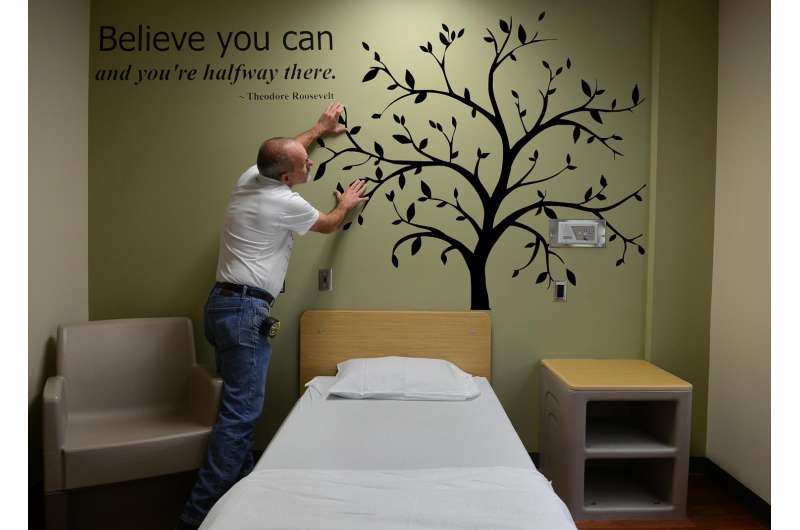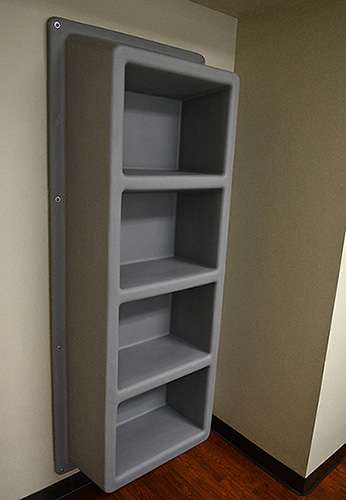Physical-environment checklist leads to sharp drop in inpatient suicides in VA

A new study shows a sharp decline in suicides at Veterans Affairs inpatient mental health units from 2000 to 2015, thanks to the Mental Health Environment of Care Checklist.
The checklist, introduced in VA in 2007 and in use at more than 150 VA hospitals nationwide, guides staff in eliminating physical hazards on mental health inpatient units that raise the risk of patient suicide or self-harm.
The study appeared online Nov. 15, 2016, in the journal Psychiatric Services.
The researchers found a sustained reduction in inpatient suicides during the last seven years of the study period, with none occurring in each of the last three years.
The checklist focuses on architectural and other physical-environment changes. Earlier analyses had shown that most attempted or completed suicides on inpatient units were linked to such hazards—for example, a hook or other anchor point that could be using for hanging.
Other potential hazards include non-shatterproof glass and non-tamper-resistant electrical outlets.
The study's lead author, Dr. Vince Watts, says the research produced two main findings.
"First, it appears that the Mental Health Environment of Care Checklist has had a substantial and persistent reduction in inpatient suicide deaths," he says. "Second, these findings suggest that architectural and environmental changes may result in more lasting effects in contrast to other improvement strategies for reducing suicides in hospital units."
Other strategies for preventing suicides in hospitals include training staff better, performing more frequent checks of patients, and implementing a non-punitive culture that rewards incident-reporting and supports its continued improvement.
Watts, a psychiatrist at the White River (Vermont) VA Medical Center, and the study's other three researchers are with the VA National Center for Patient Safety, based in Ann Arbor, Michigan.

The program was created in 1999 to lead formal patient-safety activities across the VA health system. One of its first actions was to institute a root cause analysis of adverse events such as inpatient suicide.
Root cause analysis, used widely in industry, is a systematic approach that helps organizations identify and address the underlying causes of problems, instead of just "putting out fires" when they occur.
In a review of the National Center for Patient Safety's root cause analysis database, the researchers learned of 29 completed suicides in VA mental health units from 2000 to 2015 (24 before implementation of the checklist and five after). The rate of suicide in mental health units before the program kicked off was 4.2 per 100,000 admissions. It dropped to 0.74 suicides per 100,000 admissions—an 82 percent reduction.
The new study is an extension of a 2012 report led by Watts that linked the checklist to a drop in the inpatient suicide rate at VHA mental health units.
Structural changes, according to Watts, reduce the burden on hospital staff to prevent suicides.
"The checklist and resulting environmental changes involve hardwiring of changes into the architecture of mental health units," he says. "Thus, staff don't have to remember to do something. The unit is just designed that way."
Another implication of the finding, Watts says, is that there may be other effective approaches that, like structural changes, create no added burden on staff. One such approach would be the increased use of automated technologies to help provide care for patients with mental illness.
"Technologies tend to be better at performing the same task repeatedly," he says. "This could have implications in the mental care system for veterans and non-veterans."
As for limitations of the research, Watts and his coauthors point out it's possible some inpatient suicides were not reported. This would affect the before-and-after comparisons. Also, the effects of the checklist were tracked for only seven years. Watts says the impact of the program could possibly drop in the coming years.
"Future staff could stop using it and reverse the changes," he says. "Staff members change and forget what was done and why it is done. Then one day a patient or nurse complains that they don't have a place to hang their robe. Hospital workers try to accommodate this suggestion and put a hook on the wall. Later, that hook is used as an anchor point for a suicide attempt. We hope that won't happen, but we continue to monitor in case it does."
"Our goal is to have no inpatient suicides in the VA," he adds. "Our hope is that a continued focus on this approach will result in a continued reduction in suicide."













